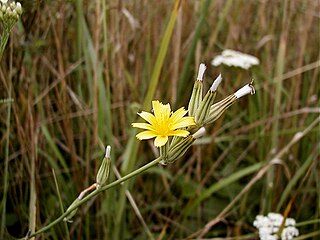
Lapsana is a genus of flowering plants in the family Asteraceae. It is native to Europe and northern Asia. Nipplewort is a common name for plants in this genus.

Ruellia is a genus of flowering plants commonly known as ruellias or wild petunias. They are not closely related to petunias (Petunia) although both genera belong to the same euasterid clade. The genus was named in honor of Jean Ruelle (1474–1537), herbalist and physician to Francis I of France and translator of several works of Dioscorides.

Utricularia resupinata, popularly known as lavender bladderwort or northeastern bladderwort, is a small perennial subaquatic carnivorous plant that belongs to the genus Utricularia. It is native to eastern Canada, the United States, and Central America. This plant species has an interesting etymology, growth pattern, ecology, and research history. As a plant that is threatened or endangered in many of the States where it is found, it is a candidate for sound conservation efforts.
This is a list of plants which includes trees and other herbs, vines, climbers, lianas, shrubs, subshrubs that are native or endemic, found in Cuba.
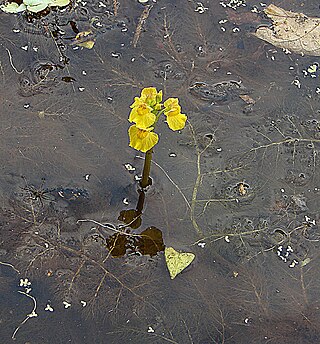
Utricularia foliosa, the leafy bladderwort, is a large suspended aquatic carnivorous plant that belongs to the genus Utricularia. It is probably a perennial plant that cultivates in lake, swamps and ponds. U. foliosa is native to Africa and North and South America, widely distributed among many countries. Although, they are widely distributed around the world, very little studies have been contributed to U. foliosa. They like to sprout all year long, and found in large body of water. The environment that Utricularia foliosa are found in are experiencing negative anthropogenic impacts such as drainage and conversion to urban or agricultural activities are causing rapid environmental degradation.

Utricularia minor, the lesser bladderwort, is a small, perennial carnivorous plant that belongs to the genus Utricularia. It is usually found affixed to the substrate but it can also survive suspended in a body of water. U. minor is a circumboreal species and is found in North America, Asia, and Europe.
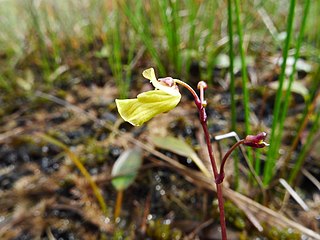
Utricularia ochroleuca, the yellowishwhite bladderwort, pale bladderwort, or cream-flowered bladderwort, is a small, perennial carnivorous plant that belongs to the genus Utricularia. It is usually found affixed to the substrate. U. ochroleuca is a circumboreal species and is found in North America, Asia, and Europe.
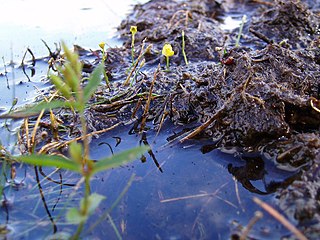
Utricularia olivacea, the piedmont bladderwort, is a very small, annual suspended aquatic carnivorous plant that belongs to the genus Utricularia. Utricularia olivacea is native to Central America, South America, the West Indies, and the eastern United States.

Utricularia radiata, the little floating bladderwort, is a medium-sized suspended aquatic carnivorous plant that belongs to the genus Utricularia. U. radiata is endemic to North America.

Utricularia purpurea, the eastern purple bladderwort, is a medium-sized suspended aquatic carnivorous plant that belongs to the genus Utricularia. U. purpurea is endemic to North and Central America. It has been suggested that U. purpurea may have partially lost its appetite for carnivory. Richards (2001) did an extensive study in the field on it and noted that trapping rates of the usual Utricularia prey were significantly lower than in other species in the genus. Richards concludes that this species can still trap and digest arthropod prey in its specialized bladder traps, but does so sparingly. Instead, it harbors a community of algae, zooplankton, and debris in the bladders that indicates U. purpurea favors a mutualistic interaction in place of a predator–prey relationship.
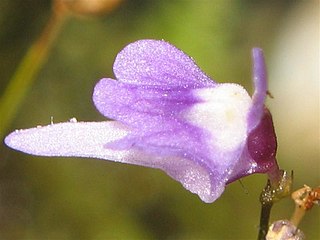
Utricularia minutissima is a small or very small terrestrial carnivorous plant that belongs to the genus Utricularia. U. minutissima is native to Asia and Australia. Among the islands of Southeast Asia, it is found on Borneo, New Guinea, and Sumatra.
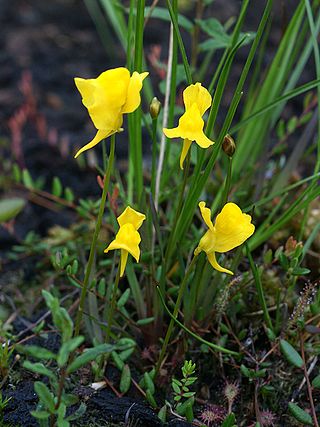
Utricularia cornuta, the horned bladderwort, is a small to medium-sized, probably perennial carnivorous plant that belongs to the genus Utricularia. U. cornuta is endemic to North America and can be found in the Bahamas, Cuba, Canada, and the United States. It grows as a terrestrial or subaquatic plant in marshes, swamps, and pools in shallow waters, mostly at lower altitudes. It was originally described and published by André Michaux in 1803.

Utricularia caerulea, the blue bladderwort, is a very small to medium-sized carnivorous plant that belongs to the genus Utricularia. U. caerulea spans a wide native range, including areas in tropical Africa, Asia, and Australia. It grows as a terrestrial plant in wet, shallow soils over rock, in wet grasslands, in swamps, or near streams in open communities, mostly at lower altitudes but ascending to as much as 2,100 m (6,890 ft). It was originally described and published by Carl Linnaeus in 1753.
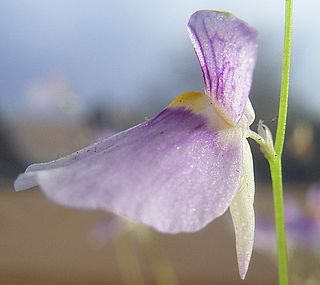
Utricularia sect. Aranella is a section in the genus Utricularia. The ten species in this section are small terrestrial carnivorous plants native to tropical South America with one species also extending into tropical Africa. John Hendley Barnhart originally described and published this section in 1913 as a separate genus, Aranella. Sadashi Komiya revised the genus Utricularia in a 1973 taxonomic review and placed Barnhart's genus at the rank of subgenus within Utricularia. Peter Taylor then published his taxonomic monograph of Utricularia in 1986 in which he reduced Komiya's subgenus to the rank of section, placing it within subgenus Utricularia. More recent phylogenetic data and revisions have reinstated subgenus Bivalvaria and have placed this section within it.
Utricularia simulans, the fringed bladderwort, is a small to medium-sized, probably perennial, carnivorous plant that belongs to the genus Utricularia. U. simulans is native to tropical Africa and the Americas. It grows as a terrestrial plant in damp, sandy soils in open savanna at altitudes from near sea level to 1,575 m (5,167 ft). U. simulans was originally described and published by Robert Knud Friedrich Pilger in 1914.
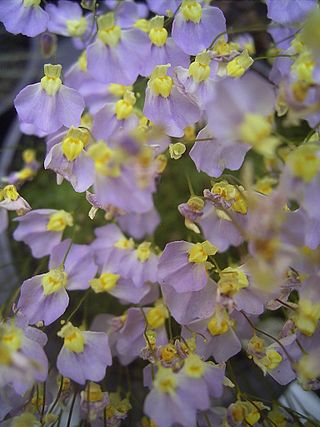
Utricularia sect. Calpidisca is a section in the genus Utricularia. The ten species in this section are small terrestrial carnivorous plants native to Africa with one species extending its range into Mexico and another that extends into Asia as far as India. John Hendley Barnhart originally described and published this section in 1916 as a separate genus, Calpidisca. Sadashi Komiya revised the genus Utricularia in a 1973 taxonomic review and placed Barnhart's genus at the rank of section within Utricularia. Peter Taylor then published his taxonomic monograph of Utricularia in 1986 in which he placed Komiya's section within subgenus Utricularia. More recent phylogenetic data and revisions have reinstated subgenus Bivalvaria and have placed this section within it.

Utricularia uliginosa, the Asian bladderwort, is a small annual carnivorous plant that belongs to the genus Utricularia. It is native to Southeast Asia, Oceania, and Australia. U. uliginosa grows as a terrestrial or subaquatic plant in seasonally flooded shallow pools with sandy soils or on banks and among rocky stream beds at low altitudes. It was originally described by Martin Vahl in 1804.

Machaerina (twigrush) is a genus of flowering plants in the sedge family. Its species occur in tropical America, the West Indies, Malesia, Australia and the Pacific region. The name comes from the Greek machaira, alluding to the shape of the leaves in the type species – Machaerina restioides.
















